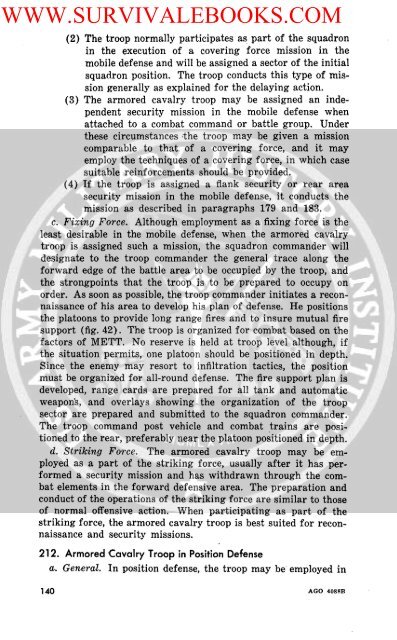FM 17-35 ( Armored Cavalry Platoon, Troop and Squadron ) 1960
FM 17-35 ( Armored Cavalry Platoon, Troop and Squadron ) 1960
FM 17-35 ( Armored Cavalry Platoon, Troop and Squadron ) 1960
You also want an ePaper? Increase the reach of your titles
YUMPU automatically turns print PDFs into web optimized ePapers that Google loves.
WWW.SURVIVALEBOOKS.COM<br />
(2) The troop normally participates as part of the squadron<br />
in the execution of a covering force mission in the<br />
mobile defense <strong>and</strong> will be assigned a sector of the initial<br />
squadron position. The troop conducts this type of mission<br />
generally as explained for the delaying action.<br />
(3) The armored cavalry troop may be assigned an independent<br />
security mission in the mobile defense when<br />
attached to a combat comm<strong>and</strong> or battle group. Under<br />
these circumstances the troop may be given a mission<br />
comparable to that of a covering force, <strong>and</strong> it may<br />
employ the techniques of a covering force, in which case<br />
suitable reinforcements should be provided.<br />
(4) If the troop is assigned a flank security or rear area<br />
security mission in the mobile defense, it conducts the<br />
mission as described in paragraphs <strong>17</strong>9 <strong>and</strong> 183.<br />
c. Fixing Force. Although employment as a fixing force is the<br />
least desirable in the mobile defense, when the armored cavalry<br />
troop is assigned such a mission, the squadron comm<strong>and</strong>er will<br />
designate to the troop comm<strong>and</strong>er the general trace along the<br />
forward edge of the battle area to be occupied by the troop, <strong>and</strong><br />
the strongpoints that the troop is to be prepared to occupy on<br />
order. As soon as possible, the troop comm<strong>and</strong>er initiates a reconnaissance<br />
of his area to develop his plan of defense. He positions<br />
the platoons to provide long range fires <strong>and</strong> to insure mutual fire<br />
support (fig. 42). The troop is organized for combat based on the<br />
factors of METT. No reserve is held at troop level although, if<br />
the situation permits, one platoon should be positioned in depth.<br />
Since the enemy may resort to infiltration tactics, the position<br />
must be organized for all-round defense. The fire support plan is<br />
developed, range cards are prepared for all tank <strong>and</strong> automatic<br />
weapon's, <strong>and</strong> overlays showing the organization of the troop<br />
sector are prepared <strong>and</strong> submitted to the squadron comm<strong>and</strong>er.<br />
The troop comm<strong>and</strong> post vehicle <strong>and</strong> combat trains are positioned<br />
to the rear, preferably near the platoon positioned in depth.<br />
d. Striking Force. The armored cavalry troop may be employed<br />
as a part of the striking force, usually after it has performed<br />
a security mission <strong>and</strong> has withdrawn through the combat<br />
elements in the forward defensive area. The preparation <strong>and</strong><br />
conduct of the operations of the striking force are similar to those<br />
of normal offensive action. When participating as part of the<br />
striking force, the armored cavalry troop is best suited for reconnaissance<br />
<strong>and</strong> security missions.<br />
212. <strong>Armored</strong> <strong>Cavalry</strong> <strong>Troop</strong> in Position Defense<br />
a. General. In position defense, the troop may be employed in<br />
140 AGO 4088B

















